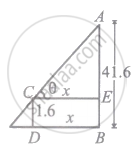Advertisements
Advertisements
प्रश्न
A man is moving away from a tower 41.6 m high at a rate of 2 m/s. If the eye level of the man is 1.6 m above the ground, then the rate at which the angle of elevation of the top of the tower changes, when he is at a distance of 30 m from the foot of the tower, is
विकल्प
`- 4/125` rad/s
`- 2/25` rad/s
`- 1/625` rad/s
None of these
उत्तर
`- 4/125` rad/s
Explanation:

Let CD be the position of man at any time t.
Let BD be x.
Then EC = x.
Let ∠ACE be θ.
Given AB = 41.6 cm, CD = 1.6 m and `(dx)/(dt)` = 2 m/s.
AE = AB – EB = AB – CD = 41.6 – 1.6 = 40 m
We have to find `(d theta)/(dt)` when x = 30 m.
From ΔAEC, tan θ = `(AE)/(EC) = 40/x`
Differentiating w.r.t. to t, sec2θ `(d theta)/(dt) = (-40)/x^2 (dx)/(dt)`
or sec2θ `(d theta)/(dt) = (- 40)/x^2 xx 2`
or `(d theta)/(dt) = (- 80)/x^2 cos^2 theta = - 80/x^2 x^2/(x^2 + 40^2) = - 80/(x^2 + 40^2)`.
When x = 30 m, `(d theta)/(dt) = - 80/(30^2 + 40^2) = - 4/125` rad/s.
